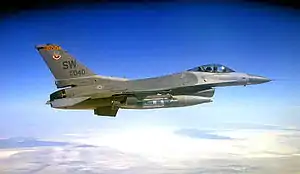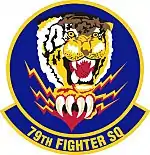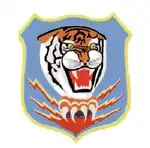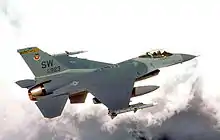79th Fighter Squadron
The 79th Fighter Squadron is part of the 20th Fighter Wing at Shaw Air Force Base, South Carolina. It operates the General Dynamics F-16 Fighting Falcon aircraft conducting air superiority missions.
79th Fighter Squadron
 | |
|---|---|
 | |
| Active | 1918; 1933–1945; 1946–1993; 1994–present |
| Country | |
| Branch | |
| Role | Fighter |
| Part of | 20th Operations Group |
| Garrison/HQ | Shaw Air Force Base |
| Nickname(s) | Tigers |
| Engagements | European Theater of Operations Desert Storm[1] |
| Decorations | Distinguished Unit Citation Air Force Outstanding Unit Award[1] |
| Commanders | |
| Notable commanders | Frank O'Driscoll Hunter James Ferguson James E. Hill John G. Lorber[1] |
| Insignia | |
| 79th Fighter Squadron emblem (updated 29 March 1996)[1] |  |
| 79 Fighter-Bomber Sq emblem (approved 31 January 1955)[2] |  |
| 79th Pursuit Squadron emblem[3] |  |
The squadron is one of the oldest in the United States Air Force, its origins dating to 22 February 1918, being organized at Rich Field, Waco, Texas, as a pilot training Squadron during World War I. The squadron saw combat during World War II, and became part of the United States Air Forces in Europe (USAFE) during the Cold War.
History
The 79th Fighter Squadron traces its history back to February 1918, when it was first organized as the 79th Aero Squadron.
The unit was inactive from November 1918 until April 1933, when it became the 79th Pursuit Squadron, flying the Boeing P-12 at Barksdale Field, Louisiana. From 1940 to 1942, the squadron trained combat pilots and flew the Curtiss P-40 Warhawk from bases on the East Coast.[4]
Second World War

In 1943, the 79th converted to the Lockheed P-38 Lightning, flying out of Northamptonshire, England, performing duties as bomber escorts and conducting fighter sweeps over Germany. The 79th remained at English bases throughout the war, supporting both the Normandy invasion and the allied drive into Germany. The squadron returned to the States and was inactivated on 19 October 1945.[4]
Post-war reactivation
The 79th was again brought to active service on 29 July 1946, at Biggs Field, Texas. The unit moved to Shaw Field, South Carolina, in October 1946. The squadron moved again to Langley Air Force Base, Virginia, in November 1951.
With NATO in Europe
In June 1952, the squadron began to train to support NATO's Allied Forces Central Europe ground forces in conventional and nuclear roles arriving at RAF Woodbridge, England, 1 October 1952, flying first the F-84G Thunderjet and then in 1955 the swept wing F-84F Thunderstreak. Redesignated as the 79th Tactical Fighter Squadron, the unit transitioned onto the North American F-100 Super Sabre in 1957 and shared RAF Woodbridge with the 78th Tactical Fighter Squadron of the 81st Tactical Fighter Wing and operated locally under the command of the 81st Wing which was based at nearby RAF Bentwaters. The next change came in 1970, when the squadron transitioned to the General Dynamics F-111 Aardvark and moved to RAF Upper Heyford, England. The 79th received the Commander in Chief's Trophy in 1981, as the best tactical fighter squadron in U.S. Air Forces in Europe.[4]
Desert Storm
From 1990 to 1991, the 79th deployed to Southwest Asia to support Operations Desert Shield and Desert Storm. On 30 June 1993 the squadron was yet again inactivated.
Return to the United States

On 1 January 1994, the 79th was reactivated at Shaw Air Force Base, South Carolina, transitioning to the General Dynamics F-16 Fighting Falcon and assuming the mission of suppression of enemy air defenses. Since that time, the 79th has continuously supported Operations Northern and Southern Watch in Southwest Asia.[4]
In December 1998, the 79th took an active part in Operation Desert Fox in conjunction with Operation Southern Watch demands. The squadron flew more than 1,000 successful combat sorties with these dual operational requirements. In January 1999, the 79th Fighter Squadron was awarded the South Carolina Air Force Association's Outstanding Air Force Unit of the Year award. Also, in 1999, the squadron was honored with the Air Combat Command's Maintenance Effectiveness Award. In June 1999, the 79th deployed F-16CJs in support of Operation Allied Force to a bare base in Southwest Asia.[4]
2013 Sequestration
Air Combat Command officials announced a stand down and reallocation of flying hours for the rest of the fiscal year 2013 due to mandatory budget cuts. The across-the board spending cuts, called sequestration, took effect 1 March when Congress failed to agree on a deficit-reduction plan.[5]
Squadrons either stood down on a rotating basis or kept combat ready or at a reduced readiness level called "basic mission capable" for part or all of the remaining months in fiscal 2013.[5] This affected the 79th Fighter Squadron, with a reduction of its flying hours, placing it into a basic mission capable status from 5 April – 30 July, then returning it to combat mission ready through September 2013.[5]
Lineage
- Squadron B, Taliaferro Field, Texas
- Organized as 79th Aero Squadron on 22 February 1918[note 3]
- Redesignated Squadron B, Taliaferro Field, Texas on 23 July 1918
- Demobilized on 15 November 1918[1]
- 79th Fighter Squadron
- Constituted as the 79th Observation Squadron on 18 October 1927
- Redesignated 79th Pursuit Squadron on 8 May 1929
- Organized as a Regular Army Inactive unit with reserve personnel on 7 September 1932[6][note 4]
- Activated on 1 April 1933[6]
- Consolidated with Squadron B, Taliaferro Field on 25 May 1933
- Redesignated 79th Pursuit Squadron (Fighter) on 6 December 1939
- Redesignated 79th Pursuit Squadron (Interceptor) on 12 March 1941
- Redesignated 79th Fighter Squadron on 15 May 1942
- Redesignated 79th Fighter Squadron (Twin Engine) on 30 December 1942
- Redesignated 79th Fighter Squadron, Two Engine on 20 August 1943
- Redesignated 79th Fighter Squadron, Single Engine on 5 September 1944
- Inactivated on 18 October 1945
- Activated on 29 July 1946
- Redesignated 79th Fighter Squadron, Jet on 15 June 1948
- Redesignated 79th Fighter-Bomber Squadron on 20 January 1950
- Redesignated 79th Tactical Fighter Squadron on 8 July 1958
- Redesignated 79th Fighter Squadron on 1 October 1991
- Inactivated on 30 June 1993
- Activated on 1 January 1994.[1]
Assignments
- Unknown, 22 February–15 November 1918[note 5]
- Eighth Corps Area, 18 October 1927 (in inactive status)[6]
- 20th Pursuit Group (later 20th Fighter Group), 1 April 1933 – 18 October 1945
- 20th Fighter Group (later 20th Fighter-Bomber Group), 29 July 1946 (attached to 20th Fighter-Bomber Wing after 15 November 1952)
- 20th Fighter-Bomber Wing (later 20th Tactical Fighter Wing), 8 February 1955 (attached to 39th Tactical Group, 1–31 August 1990 and February 1991
- 20th Operations Group, 31 March 1992 – 30 September 1993
- 20th Operations Group, 1 January 1994 – present[7]
Stations
|
|
Aircraft
- Curtiss JN-4, 1918
- Curtiss JN-6, 1918
- Thomas-Morse S-4, 1918[note 6]
- Boeing P-12, 1930–1935
- Boeing P-26 Peashooter, 1934–1938
- Curtiss P-36 Hawk, 1938–1940
- Curtiss P-40 Warhawk, 1940–1942
- Bell P-39 Airacobra, 1942–1943
- Lockheed P-38 Lightning, 1943–1944
- North American P-51 Mustang, 1944–1945, 1946–1948
- Republic F-84 Thunderjet, 1948–1957
- North American F-100 Super Sabre, 1957–1970
- General Dynamics F-111 Aardvark, 1970–1993
- General Dynamics F-16 Fighting Falcon, 1994–present[1]
See also
References
Notes
- Explanatory notes
- Aircraft is General Dynamics F-16C Block 50 Fighting Falcon serial 94-49. Taken in 2002.
- Aircraft is General Dynamics F-16C Block 50P serial 92-3923, taken on 11 August 2001.
- This squadron is not related to the 79th Aero Squadron organized on 15 August 1917 at Kelly Field, Texas and redesignated 491st Aero Squadron on 1 February 1918.
- Regular Army Inactive units were units that were constituted in the regular army. Although they were not activated, they were organized with reserve personnel during the 1920s and early 1930s. Even though they had reserve personnel assigned, they were not Organized Reserve units. Because they had no regular personnel they were still considered inactive in the regular army. Clay, p. vi
- If location at Waco, Texas was Rich Field, probably assigned to Post Headquarters, Rich Field, then after move to Hicks, Texas to Post Headquarters, Talliaferro Field.
- Aircraft operated in 1918, particularly the S-4, are not certain. Robertson.
- Citations
- Robertson, Patsy (25 February 2008). "Factsheet 79 Fighter Squadron (ACC)". Air Force Historical Research Agency. Retrieved 2 October 2017.
- Maurer, Combat Squadrons, pp.281–282
- Hubbard, p. 718
- "Library: Fact Sheet 79th Fighter Squadron". 20th Fighter Wing Public Affairs. 10 July 2009. Archived from the original on 26 September 2015. Retrieved 3 October 2017.
- Everstein, Brian; Weisgerber, Marcus (8 April 2013). "Reduced flying hours forces grounding of 17 USAF combat air squadrons". Military Times. Retrieved 4 October 2016.
- Clay, p. 1428
- Assignment information in Robertson, except as noted.
- Station number in Anderson
- Station information in Robertson, except as noted.
Bibliography
![]() This article incorporates public domain material from the Air Force Historical Research Agency.
This article incorporates public domain material from the Air Force Historical Research Agency.
- Anderson, Capt. Barry (1985). Army Air Forces Stations: A Guide to the Stations Where U.S. Army Air Forces Personnel Served in the United Kingdom During World War II (PDF). Maxwell AFB, AL yes: Research Division, USAF Historical Research Center. Archived from the original (PDF) on 23 January 2016. Retrieved 28 June 2017.
- Clay, Steven E. (2011). US Army Order of Battle 1919–1941 (PDF). Vol. 3 The Services: Air Service, Engineers, and Special Troops 1919–1941. Fort Leavenworth, KS: Combat Studies Institute Press. ISBN 978-0-98419-014-0. LCCN 2010022326. OCLC 637712205. Archived from the original (PDF) on 27 September 2013. Retrieved 16 October 2012.
- Hubbard, Gerardl (1943). "Aircraft Insignia, Spirit of Youth". The National Geographic Magazine. National Geographic Society. LXXXIII (6): 718–722. Retrieved 1 September 2017. (subscription required for web access)
- Maurer, Maurer, ed. (1983) [1961]. Air Force Combat Units of World War II (PDF) (reprint ed.). Washington, DC: Office of Air Force History. ISBN 0-912799-02-1. LCCN 61060979. Retrieved 17 December 2016.
- Maurer, Maurer, ed. (1982) [1969]. Combat Squadrons of the Air Force, World War II (PDF) (reprint ed.). Washington, DC: Office of Air Force History. ISBN 0-405-12194-6. LCCN 70605402. OCLC 72556. Retrieved 17 December 2016.
- Ravenstein, Charles A. (1984). Air Force Combat Wings, Lineage & Honors Histories 1947-1977. Washington, DC: Office of Air Force History. ISBN 0-912799-12-9. Retrieved 17 December 2016.
- Order of Battle of the United States Land Forces in the World War. Vol. 3, Part 3 Zone of the Interior: Directory of Troops (Reprint ed.). Washington, DC: Center of Military History. 1988 [1949]. Archived from the original on 23 October 2016. Retrieved 22 January 2017.
